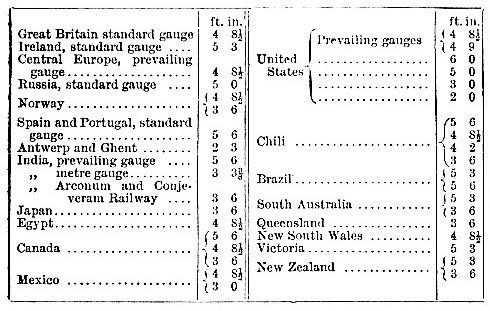1902 Encyclopedia > Railway, Railways (Railroad) > Permanent Way. Gauge.
Railway, Railways
(Part 26)
E. PERMANENT WAY
Permanent Way. Gauge.
Permanent Way
The permanent way consists of rails, chairs, spikes, keys, and sleepers laid in a bed of ballast deposited on the formation. The sleepers or substructure should be bedded on broken stones, cinders, or gravel, at least 12 inches in depth under the sleepers, without any clay or other material in it that might interfere with the drainage of water through the ballast to the formation.
Gauge
The measure of the standard or British national gauge of railways is 4 feet 8 1/2 inches of width between the rails forming a line of rails or a way. There are many other gauges in existence indifferent parts of the world. In England the gauge of 7 feet, originally adopted on the Great Western Railway, was known as the "broad gauge" in contradistinction to the ordinary gauge of 4 feet 8 1/2 inches, which was for a long time known as the "narrow gauge." But the 7 feet gauge has been to a great extent replaced by the 4 feet 8 1/2 inch or national gauge, and it is being gradually replaced altogether. The lengths of line now (1885) laid on the two gauges on the Great Western Railway are as follows:—

The name of "narrow gauge" has now ceased to be applicable to the standard gauge, and is reserved for gauges of much less width,—the metre gauge and others of from 2 to 3 or 3 1/2 feet wide. Why a fractional measure of gauge should have been selected is a question which has puzzled many people. The fact seems to be that the track of the original cars of trains—5 feet wide outside the wheels—was taken as a standard for the gauge of rails, which was measured outside also. The width of the single rail at the top being originally 1 3/4 inches, the width for the two rails together is 3 1/2 inches, which leaves 4 feet 8 1/2 inches for the inside measure or true gauge. There are in the United Kingdom a few railways of gauge narrower than the standard gauge, of which instances occur in the following lines:—Festiniog, 1 foot 11 1/2 inches; Talyllyn, 2 feet 6 inches; Dinas and Snowdon, Southwold, Isle of Man, Manx Northern, Revenglass and Eskdale, Ballymena, and Larne, each 3 feet. The following statement (Table XXXVII.) comprises the gauges of the principal railway systems in the world:—

The relative advantages of broad gauges and narrow gauges were exhaustively discussed at the Institution of Civil Engineers (in 1873), on the reading of Mr. W. T. Thornton’s paper on "The Relative Advantages of the 5 feet 6 inch Gauge and of the Metre Gauge for the State Railways of India." The fallacy pervading the arguments for narrow gauges is that they take the width between the rails as the basic unit of the system; whereas that is really little more than an incident, and the dimensions of the railway must in point of fact be governed by the size and weight of the vehicles which the traffic requires. Speaking generally, the national gauge of 4 feet 8 1/2 inches is at least as good as any other for the purposes of general traffic. If the width of gauge were still an open question, it might be maintained that a gauge of 5 feet would be rather more convenient in view of the increasing size of the more powerful locomotives.
Read the rest of this article:
Railway, Railways - Table of Contents
|

